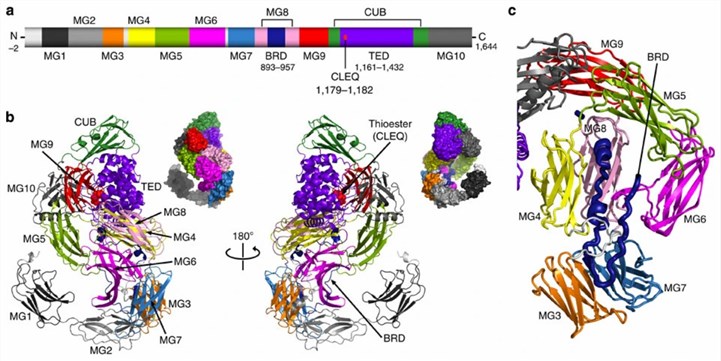What is A2M Protein
A2M protein is derived from alpha-2-macroglobulin, a large plasma glycoprotein synthesized primarily in the liver that has multiple functions.
What is A2M Protein?
A2M, a tetrameric glycoprotein, showcases a distinctive structure pivotal to its functionality. Comprising four identical subunits, each housing macroglobulin and bait domains, A2M exhibits a sophisticated molecular architecture. The macroglobulin domains confer size and shape, enabling A2M to interact with diverse molecules. Meanwhile, the bait regions serve as molecular traps for proteases, elucidating A2M's role as a protease inhibitor.

Figure 1. Crystal structure of S. typhimurium alpha-2-macroglobulin (Sa-A2M). (Wong, S., et al. 2014)
The Function of A2M Protein
A2M's functional repertoire extends beyond protease inhibition. Synthesized in the liver and released into the bloodstream, A2M plays a crucial role in clearing macromolecular waste and cellular debris. Its ability to encapsulate and sequester molecules facilitates their removal, contributing to systemic homeostasis.
In the immune response, A2M emerges as a modulator of immune-related molecules. Its broad interaction spectrum allows it to influence responses to infection, inflammation, and tissue repair. As a protease inhibitor, A2M regulates enzymatic activities, emphasizing its pivotal role in maintaining physiological balance.
A2M-Related Diseases
Associations between A2M and diseases shed light on its intricate involvement in pathophysiological processes. In Alzheimer's disease, A2M's interaction with beta-amyloid suggests potential implications in plaque formation. In osteoarthritis, altered A2M levels point towards its significance as a biomarker, offering insights into disease progression.
A2M's involvement in certain cancers underscores its potential as a diagnostic indicator. Understanding the nuanced connections between A2M and diseases paves the way for targeted diagnostic and therapeutic interventions, potentially revolutionizing treatment approaches.
A2M Related Signaling Pathways
The signaling pathways associated with A2M further elucidate its involvement in various physiological processes. A2M is known to modulate the activity of several key pathways, including the transforming growth factor-beta (TGF-β) pathway, nuclear factor kappa B (NF-κB) pathway, and Janus kinase/signal transducer and activator of transcription (JAK/STAT) pathway.
- TGF-β Pathway
In the TGF-β pathway, A2M has been shown to influence the activity of this crucial signaling cascade, which plays a pivotal role in cell growth, differentiation, and immune regulation. By interacting with components of the TGF-β pathway, A2M can modulate cellular responses to environmental stimuli, contributing to the fine-tuning of cellular behaviors.
- NF-κB Pathway
The NF-κB pathway, a central player in inflammation and immune responses, is also subject to modulation by A2M. A2M's ability to interact with NF-κB components highlights its role in the regulation of inflammatory processes. Understanding the nuances of this interaction may have implications for the development of anti-inflammatory therapies.
- JAK/STAT Pathway
The JAK/STAT pathway, essential for the regulation of immune responses and cellular proliferation, is another key signaling cascade influenced by A2M. By modulating this pathway, A2M contributes to the orchestration of immune reactions and the maintenance of tissue homeostasis.
Applications of A2M in Biomedical Research
The versatility of A2M positions it as a promising candidate in biomedical research and therapeutics. As a potential biomarker, A2M's utility in diagnosing and monitoring diseases like osteoarthritis and Alzheimer's offers a personalized approach to healthcare.
In regenerative medicine, A2M's modulation of growth factors and cytokines opens doors to innovative therapies. Harnessing its capabilities may pave the way for tissue repair and regeneration, providing novel strategies for treating musculoskeletal disorders.
The protease inhibition property of A2M sparks interest in therapeutic applications. Designing targeted therapies based on A2M's ability to neutralize specific proteases holds promise for conditions where protease imbalance contributes to pathogenesis.
As research advances, the potential for A2M to revolutionize diagnostics and therapeutics beckons, offering hope for innovative solutions to complex health challenges.
Recommended Products for A2M Protein
| Cat.# | Species | Product name | Source (Host) | Tag |
|---|---|---|---|---|
| A2M-6857H | Human | Active Recombinant Human A2M protein, His-tagged | Insect Cells | His |
| A2M-003H | Human | Recombinant Human A2M Protein, GST-tagged | Wheat Germ | GST |
| A2M-499H | Human | Recombinant Human A2M Protein, Myc/DDK-tagged, C13 and N15-labeled | HEK293T | Myc/DDK |
| A2M-1097HFL | Human | Recombinant Full Length Human A2M Protein, C-Flag-tagged | Mammalian cells | Flag |
| A2M-239H | Human | Recombinant Human A2M Protein, His (Fc)-Avi-tagged | HEK293 | His (Fc)-Avi |
| A2m-5732M | Mouse | Recombinant Mouse A2m protein, His-tagged | E.coli | His |
| A2m-02M | Mouse | Recombinant Mouse A2m Protein, His-tagged | E.coli | N-His |
| A2m-5734R | Rat | Recombinant Rat A2m protein, His-tagged | E.coli | His |
| A2M-32R | Rat | Recombinant Rat A2M Protein, His (Fc)-Avi-tagged | HEK293 | His (Fc)-Avi |
| a2M-3326P | Pig | Recombinant Pig a2M, His-tagged | E.coli | His |
Reference
- Wong, S., Dessen, A. Structure of a bacterial α2-macroglobulin reveals mimicry of eukaryotic innate immunity. Nat Commun. 2014, 5: 4917.

